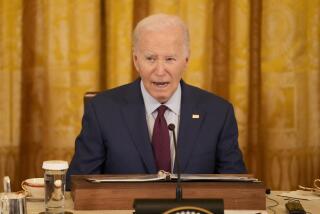Senate passes student loan plan
WASHINGTON — A plan to restore lower interest rates on most college loans won Senate approval Wednesday, despite objections from a bloc of Democrats who warned it could ultimately increase the cost of a degree for many students.
The legislation, which is supported by President Obama and is expected to swiftly pass the House, would reinstate a market-based approach for calculating rates, tying them to the 10-year Treasury note. The new rate for undergraduate Stafford loans would be about 3.8% this year, slightly above the rate that expired July 1.
The final vote was 81-18. Sixteen Democrats, joined by Sens. Mike Lee (R-Utah) and Bernie Sanders (I-Vt.), voted no.
A market-based system had been in place until 2006, when the rate was fixed at 6.8%. It was later gradually reduced to 3.4%.
PHOTOS: 2013’s memorable political moments
Democrats successfully mounted an election-year campaign in 2012 to extend that lower rate for an additional year. As rates were set to return to 6.8% this year, congressional Democrats pushed for another temporary extension. But they found their position weakened by a White House budget plan that supported a return to a market-based plan.
The Republicans who lead the House passed legislation in May that they said mirrored the administration’s approach, putting pressure on the Democratic-controlled Senate to prevent rates from doubling. Twice, Democrats in the Senate failed to overcome a filibuster to advance their favored approach, setting the stage for talks that resulted in the compromise plan that passed Wednesday.
As the economy improved and deficit concerns persisted, the issue sparked a debate over whether student loan programs should be a moneymaker for the federal government. The negotiations sought to set rates in a way that would result in minimal profits — $715 million over 10 years, according to the Congressional Budget Office.
Sen. Richard J. Durbin (D-Ill.), who helped mediate talks among Republicans, Democrats and the White House, called it the best solution for students and taxpayers. He also said lawmakers would have another opportunity to find ways to lower college costs when the Senate considers the reauthorization of the Higher Education Act next year.
PHOTOS: Team Obama, where are they now?
“We understand that it’s more than the interest rate that’s causing a problem,” he said. “Let’s give the students and families the help they need today, but let’s not stop on the issue.”
But Democrats opposed to the plan noted that although rates would be lower in the short term, they are expected to rise to an estimated 7.25% by 2018 as bond rates increase in an improving economy. The plan includes a cap of 8.25% on undergraduate loans to protect against increases beyond those forecast.
Despite a late effort by the White House to push the plan over the finish line, signs of disunity remained until the end. Sens. Jack Reed (D-R.I.) and Elizabeth Warren (D-Mass.) offered an amendment to set the interest cap at 6.8%, but it failed. Any increase to the deficit from the lower cap would have been offset by a tax surcharge on incomes of more than $1 million.
“For the first time in the history of the student loan program, we’re actually sort of reversing the subsidy,” Reed said. “Education is so important to the future of America that we’re no longer going to invest in it as a nation, we’re going to let students pay.”
Another amendment from Sanders, which would have required lawmakers to revisit the issue in two years, also failed.
“This bill makes a bad situation worse, not better,” Sanders said. “We have got to get out of the business of making profits off of struggling families who want nothing better than to be able to send their kids to college.”
Senate Minority Leader Mitch McConnell (R-Ky.) said it was about time that Senate Democrats joined Republicans and the president in “enacting real, permanent reform for students.”
Follow Politics Now on Twitter and Facebook
Twitter: @mikememoli
More to Read
Start your day right
Sign up for Essential California for news, features and recommendations from the L.A. Times and beyond in your inbox six days a week.
You may occasionally receive promotional content from the Los Angeles Times.







